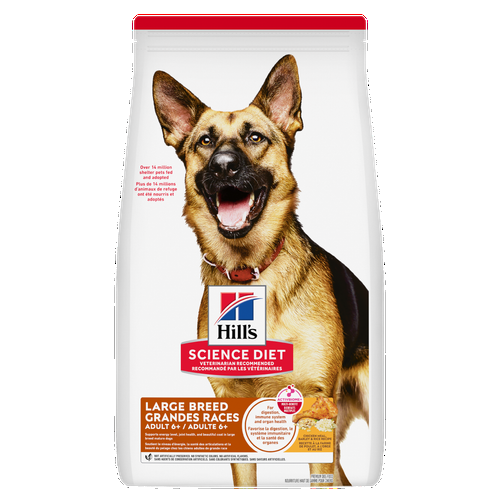
-
Find the right food for your petTake this quiz to see which food may be the best for your furry friend.Find the right food for your petTake this quiz to see which food may be the best for your furry friend.Featured products
 Adult Chicken & Barley Recipe Dog Food
Adult Chicken & Barley Recipe Dog FoodSupports healthy immune system, digestion, lean muscle & beautiful coat
Shop Now Adult 7+ Small & Mini Chicken & Brown Rice Recipe Dog Food
Adult 7+ Small & Mini Chicken & Brown Rice Recipe Dog FoodSupports energy level & luxurious coat in Small & Mini dogs. Helps keep immune system, heart & kidneys healthy.
Shop Now Adult Large Breed Chicken & Barley Recipe Dog Food
Adult Large Breed Chicken & Barley Recipe Dog FoodSupports healthy joints, immune system, digestion, lean muscle & beautiful coat
Shop NowFeatured products Adult Urinary Hairball Control Chicken & Rice Recipe Cat Food
Adult Urinary Hairball Control Chicken & Rice Recipe Cat FoodSupports the health of the whole urinary system with optimal levels of magnesium
Shop Now Adult 7+ Chicken Recipe Cat Food
Adult 7+ Chicken Recipe Cat FoodSupports energy level & beautiful fur. Helps keep immune system, heart & kidneys healthy.
Shop Now Adult Oral Care Chicken & Brown Rice Recipe Cat Food
Adult Oral Care Chicken & Brown Rice Recipe Cat FoodClinically proven kibble technology to reduce plaque & tartar build-up
Shop Now -
Dog
- Dog Tips & Articles
-
Health Category
- Weight
- Food & Environmental Sensitivities
- Urinary
- Digestive
- Joint
- Kidney
- Dental
- Cancer
-
Life Stage
- Puppy Nutrition
- Adult Nutrition
- Senior Nutrition
Cat- Cat Tips & Articles
-
Health Category
- Weight
- Skin & Food Sensitivities
- Urinary
- Digestive
- Kidney
- Dental
- Stress
- Cancer
-
Life Stage
- Kitten Nutrition
- Adult Nutrition
Featured articles Compare Your Pet Food's Calories to Other Brands
Compare Your Pet Food's Calories to Other BrandsCompare Hill's Science Diet dog and cat food's calories against other pet food brands and AAFCO recommended maximum calorie count.
Read More Pet Food Storage Tips
Pet Food Storage TipsDiscover how and where to store your dry, as well as canned, dog and cat food. Learn how to find the "best before" dates on all Hill's pet food packaging.
Read More The Incredible Science Behind Your Pet's Microbiome
The Incredible Science Behind Your Pet's MicrobiomeLearn what a pet's microbiome is, how it contributes to your pet's gut & overall health, and why nutrition is important in maintaining healthy microbiomes.
Read More -


If you're reading this, there's a good chance that you're right-handed. According to WorldAtlas, only 10 percent of the human population are lefties. But have you ever wondered if dogs have dominant paws like humans have dominant hands? And are dogs right- or left-handed, on average? Find out how pet researchers — and you too! — can determine whether a dog is a righty or lefty.
Understanding Paw Preference
Like humans, all dogs are different, so there's no definitive answer to the question as to whether or not a dog is left or right-pawed Another reason why it's hard to nail down statistics is that dogs aren't formally tested for dominant paws. However, many experts believe that dogs have a more equal chance than humans of being either righties or lefties. And while many dogs have dominant paws, many also have no preference between their right and left paws.
How Researchers Determine Paw Preference
Two of the most popular ways to determine a dog's paw preference is through the Kong test and the first-stepping test, both of which have been used in scientific studies. Here's how they work.

The Kong Test
In a Kong test, a dog is given a rubber, cylindrical dog toy called a Kong, which is filled with food. You then watch the dog to see how many times they use each paw to hold the toy while trying to get the food out. According to the American Kennel Club, Kong tests tend to show that dogs are equally likely to be left-pawed, right-pawed and to have no preference.
The First-Stepping Test
You can also determine a dog's paw preference through the first-stepping test. With this test, you watch to see which paw a dog puts down first as they prepare to walk. This indicates which paw they prefer. According to the author of a study in the Journal of Veterinary Behavior, the first-stepping test shows more significant paw preferences than the Kong test. This particular first-stepping test revealed a strong preference among dogs for the right paw.


Tasty Tips
What About My Dog?
If you'd like to know which paw your own pup prefers, try an at-home experiment. You can either use one of the scientist-approved tests or create a new one your pet might like more. For example, when you ask your dog to give you their paw, do they always extend the same one? What happens if you hide a treat in your hand? Does your dog extend the same paw to touch the hand that's holding the treat? Games like this can help you determine if your pet has a paw preference.
Keep in mind that if you want accurate results, you'll have to perform a paw preference test over an extended period of time. Both the Kong test and the first-stepping test require 50 observations for accurate data.
Whether you decide to take a serious, scientific approach or not, your dog is sure to love participating in a paw preference test — especially if it involves food!


Erin Ollila believes in the power of words and how a message can inform—and even transform—its intended audience. Her writing can be found all over the internet and in print, and includes interviews, ghostwriting, blog posts, and creative nonfiction. Erin is a geek for SEO and all things social media. She graduated from Fairfield University with an M.F.A. in Creative Writing. Reach out to her on Twitter @ReinventingErin or learn more about her at http://erinollila.com.
Related products

Beef & Barley recipe with precisely balanced nutrition to support mobility and muscle mass for older dogs.

Beef & Barley recipe with precisely balanced nutrition to keep adult dogs active and healthy

Supports energy & beautiful coat. Helps keep immune system, joints, heart & kidneys healthy

Supports energy level & luxurious coat in Small & Mini dogs. Helps keep immune system, heart & kidneys healthy.
Related articles

Gather the following puppy supplies to prepare your family for all the fun (and commitment) that comes with being a dog parent.

Learn how to stop your dog from begging at the dinner table, and understand how it can help contribute to his health.

Proper nutrition for your pregnant or nursing dog is vital to her and her puppy's health. Learn what you should do provide her with the proper nutrients.

Discover fun and engaging games and other ways to help your dog exercise, keeping him happy and healthy.

Put your dog on a diet without them knowing
Our low calorie formula helps you control your dog's weight. It's packed with high-quality protein for building lean muscles, and made with purposeful ingredients for a flavorful, nutritious meal. Clinically proven antioxidants, Vitamin C+E, help promote a healthy immune system.
Put your dog on a diet without them knowing
Our low calorie formula helps you control your dog's weight. It's packed with high-quality protein for building lean muscles, and made with purposeful ingredients for a flavorful, nutritious meal. Clinically proven antioxidants, Vitamin C+E, help promote a healthy immune system.

